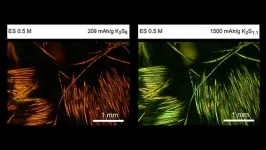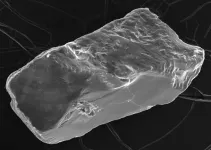(Press-News.org) Key takeaways
The cumulative adversity index for people quantifies numerous measures of hardship, such as poverty and stress to understand health and longevity over the individual’s lifespan.
A similar tool could help scientists who study and want to conserve animal populations by identifying the most influential stressors to mitigate.
UCLA biologists have created the first cumulative adversity index for yellow-bellied marmots. They found that as in humans, adversity early on had lifelong consequences and reduced their life expectancy.
Adversity early in life can have permanent health consequences for people — even if their circumstances improve dramatically later on. Scientists use a cumulative adversity index, or CAI, which quantifies measures of hardship including poverty and stress, to understand health and longevity over the course of an individual’s life. This has been helpful in identifying specific measures governments, health care providers and families can take to improve people’s lives.
Wild animals may also experience adversity early in life, but the effect on their survival and longevity is unknown. While a similar tool could help scientists conserve animal populations by identifying the most influential stressors to mitigate, few populations have been studied over a long enough time to get the data needed to develop a CAI for that species.
UCLA biologists are changing that by creating the first cumulative adversity index for yellow-bellied marmots, based on 62 years of continuous data collection at the Rocky Mountain Biological Laboratory in Colorado. This is the second-longest study of individually marked mammals in the world. The new study, published in Ecology Letters, offers detailed steps for scientists with large datasets for other species to create their own CAI.
The index they developed identified some predictable but also surprising stressors with significant effects on marmot survival and longevity. For example, it was no surprise a late start of the growing season reduced survival because marmots must gain weight during the summer for their 7- to 8-month hibernation. But the finding that summer drought had no effect was unexpected. Predation also played a smaller-than-anticipated role. Not surprisingly, a mother’s death played a large role — but it still did even if it occurred after the pup was weaned. That may be because pups live with their mother for a full year after weaning.
To create the index, doctoral student Xochitl Ortiz-Ross selected data for female marmots born after 2001 — when the researchers started quantifying physiological stress — that remained in one of the studied colonies until 2019, to guarantee an accurate record of their pedigree, age and lifetime experiences. Males typically disperse while females remain in the area where they are born, so biologists can observe females during their lifespan.
This population of marmots spans a 984-foot (300-meter) elevation change that divides the population into up-valley and down-valley groups, with different environmental and demographic conditions. The scientists trap individuals in the population biweekly from spring through late summer, when the marmots are active, collecting behavioral, morphological and physiological data.
Ortiz-Ross identified the following ecological, demographic and maternal measures of adversity, all of which can affect if a pup survives its first year: late start of season; summer drought; predation pressure; large litters; male-biased litters; late weaning; poor maternal mass; high maternal stress; and maternal loss. She wanted to find out if these factors had any effect on the length of an individual’s lifespan after the first year.
These variables were fed into computer models that quantified standard, mild, moderate and acute adversity. All models yielded similar results. Moderate and acute cumulative adversity decreased the odds of pup survival by 30% and 40%, respectively. Pup survival odds were significantly higher up-valley for all models, while maternal loss decreased survival odds in all models and by up to 64% in the moderate adversity model. Poor maternal mass decreased chances of survival by 77% only in the moderate adversity model, while late weaning decreased odds by 33% only in the standardized and raw models. Surprisingly, drought increased odds of survival across all but the acute adversity model, with the greatest effect observed in the moderate adversity model.
The average adult lifespan was 3.8 years, but acute CAIs tripled the risk of adverse effects on life expectancy.
“We found that a CAI effectively captures short-term survival risk in yellow-bellied marmots, and even in the long term, increased adversity early in life lowered the adult lifespan,” Ortiz-Ross said. “Positive effects didn’t cancel out earlier adverse ones, suggesting that adversity does accumulate in marmots and can’t be fully recovered by positive experiences.”
The results supported the hypothesis that a CAI can be a useful tool to evaluate the long-term survival impact of multiple early life stressors in yellow-bellied marmots.
“What we’re facing in terms of biodiversity management is death by a thousand cuts. We typically study one factor at a time: humans, predators, climate and so forth,” said Daniel Blumstein, co-author and professor of ecology and evolutionary biology. “But these impacts occur together and have a cumulative effect. We need a way to figure out which of these stressors — or which combination — has the biggest cumulative effect, and our research shows the CAI can do that for marmots.”
For example, conservation plans targeting this marmot population might target the down-valley group which surprisingly, fared a little worse, and on reducing maternal mortality and improving the health of mothers. But they might not need to target reducing predation or countering the effects of summer drought; these did not turn out to be as important as expected.
END
Hardship early in life can affect health and longevity – even for marmots
A cumulative adversity index created by researchers could be adapted to help conservation efforts
2024-09-16
ELSE PRESS RELEASES FROM THIS DATE:
Chances of successful pregnancy are the same with embryo transfer on day three or five
2024-09-16
In IVF treatment, embryos are traditionally transferred in the uterus three days after fertilization. Due to improvements in laboratory techniques, this is now also possible after five days. It was assumed that this increases the chance of a successful pregnancy. A study by Radboud university medical center and Amsterdam UMC shows that the day of transfer does not influence the success rate of the IVF trajectory.
One out of thirty children in the Netherlands is conceived via in vitro fertilization, or IVF for short. In this procedure, ...
The Lancet: More than 39 million deaths from antibiotic-resistant infections estimated between now and 2050, suggests first global analysis
2024-09-16
Embargoed access to the paper and contact details for authors are available in Notes to Editors at the end of the release.
The Lancet: More than 39 million deaths from antibiotic-resistant infections estimated between now and 2050, suggests first global analysis
First in-depth analysis of global health impacts of antimicrobial resistance (AMR) over time reveals trends from 1990 to 2021 and estimates potential impacts to 2050 for 204 countries and territories.
More than one million people died from AMR globally each year between 1990 and 2021. Over the period, AMR deaths among children aged under five declined by 50% while those among people aged 70 ...
Fraunhofer IAF low-noise amplifiers aboard the Arctic Weather Satellite
2024-09-16
The Arctic Weather Satellite (AWS) of the European Space Agency (ESA) was sent on its journey to a polar orbit 600 km above the Earth on August 16, 2024. On board: four low-noise amplifiers (LNAs) from the Fraunhofer Institute for Applied Solid State Physics IAF in Freiburg. They are essential components of the passive microwave radiometer with which the AWS measures temperature and humidity in the Arctic more precisely than ever before. This should contribute to a better understanding of both the Arctic and the climate change that is particularly visible in it. If the mission is successful, ...
Immunotherapy after surgery helps people with high-risk bladder cancer live cancer-free longer
2024-09-16
Results from a large clinical trial show that treatment with an immunotherapy drug may nearly double the length of time people with high-risk, muscle-invasive bladder cancer are cancer-free following surgical removal of the bladder. Researchers found that postsurgical treatment with pembrolizumab (Keytruda), which is approved by the Food and Drug Administration (FDA) for treating at least 18 different cancers, was superior compared with observation. The study, led by researchers at the National Institutes of Health (NIH), ...
US COVID-19 rates oscillate every six months
2024-09-16
COVID-19 cases in the U.S. have shown unexpected oscillating waves every six months between the southern states and the northern states and, to a lesser degree, from east to west, according to new research published today in Scientific Reports.
Public health scientists from the University of Pittsburgh, University of Ottawa and University of Washington conducted the first detailed analysis to demonstrate and characterize the six-month oscillation of cases across space and time. It provides key information ...
Lower neighborhood opportunity may increase risk for preterm birth
2024-09-16
FOR IMMEDIATE RELEASE
Monday, September 16, 2024
Contact:
Jillian McKoy, jpmckoy@bu.edu
Michael Saunders, msaunder@bu.edu
##
Lower Neighborhood Opportunity May Increase Risk for Preterm Birth
A new study suggests that neighborhoods with fewer educational, health, environmental, and socioeconomic resources may increase one’s risk for preterm birth and contribute to the racial gap in preterm birth in the Commonwealth.
Preterm birth, defined as a live birth before 37 weeks of pregnancy, is the second-leading cause of infant mortality in the United States, and one that disproportionately affects Black and ...
Analysis finds cardiac devices recalled for safety reasons infrequently subjected to premarket or postmarket testing
2024-09-16
Embargoed for release until 5:00 p.m. ET on Monday 16 September 2024
@Annalsofim
Below please find summaries of new articles that will be published in the next issue of Annals of Internal Medicine. The summaries are not intended to substitute for the full articles as a source of information. This information is under strict embargo and by taking it into possession, media representatives are committing to the terms of the embargo not only on their own behalf, but also on behalf of the organization they represent.
----------------------------
1. ...
Trailblazers in plasma turbulence computer simulations win 2024 James Clerk Maxwell Prize
2024-09-16
A pair of physicists with long ties to PPPL are being honored for their foundational work on turbulence in plasma. Understanding why instabilities occur and how to limit them is critical to perfecting fusion as a stable energy source for the electrical grid.
Greg Hammett, a PPPL theoretical and computational principal research physicist, and Bill Dorland, former associate laboratory director for computational sciences and current Lab adviser, have won the 2024 James Clerk Maxwell Prize for Plasma Physics. The American ...
Technology could boost renewable energy storage
2024-09-16
Renewable energy sources like wind and solar are critical to sustaining our planet, but they come with a big challenge: they don't always generate power when it's needed. To make the most of them, we need efficient and affordable ways to store the energy they produce, so we have power even when the wind isn't blowing or the sun isn't shining.
Columbia Engineering material scientists have been focused on developing new kinds of batteries to transform how we store renewable energy. In a new study published September 5 by Nature Communications, the team used K-Na/S batteries that combine inexpensive, readily-found elements -- ...
Introducing SandAI: A tool for scanning sand grains that opens windows into recent time and the deep past
2024-09-16
Stanford researchers have developed an artificial intelligence-based tool – dubbed SandAI – that can reveal the history of quartz sand grains going back hundreds of millions of years. With SandAI, researchers can tell with high accuracy if wind, rivers, waves, or glacial movements shaped and deposited motes of sand.
The tool gives researchers a unique window into the past for geological and archeological studies, especially for eras and environments where few other clues, such as fossils, are preserved ...
LAST 30 PRESS RELEASES:
The Great Bear Rainforest nature writing retreat
Research reveals hidden diversity of E. coli driving diabetic foot infections
Breakthrough in parallel Cartesian grid generation: Dynamic partition weight strategy resolves load imbalance
ESMT Berlin study shows how startups can communicate to win over silent audiences online
Design and optimization of wide-speed double swept waverider based on curved-cone projection method
Giant Magellan Telescope names Daniel T. Jaffe as president
New parameterization method for cislunar space cataloging enhances orbital awareness in Earth-Moon system
A “nu” way to measure researcher impact
Dark matter may have begun much hotter than scientists thought
Board games boost young kids’ math skills, UO research review shows
Unleashing floods: Researchers learn more about how fossils form
An open-source robotic system to perform cell culture tasks
Fathers’ health influences offspring through sperm RNAs
Korea University study mimics heart mechanics in organoids using three-dimensional magnetic torque
Catching a radical in motion with µSR spectroscopy
Hanbat National University researchers reveal smart transparent woods that block UV and save energy
Rhythm contains important information for the cell
Nitrogen is key to faster regrowth in deforested areas, say researchers
Recovering tropical forests grow back nearly twice as fast with nitrogen
A new diet option for mild-to-moderate Crohn’s disease
Electric vehicles could catch on in Africa sooner than expected
New test could help pinpoint IBD diagnosis, study finds
Common eye ointment can damage glaucoma implants, study warns
ACCESS-AD: a new European initiative to accelerate timely and equitable AD diagnosis, treatment and care
Mercury exposure in northern communities linked to eating waterfowl
New Zealand researchers identify brain link to high blood pressure
New research confirms people with ME/CFS have a consistent faulty cellular structure
Hidden cancer risk behind fatty liver disease targets
Born in brightness, leading to darkness
Boron-containing Z-type and bilayer benzoxene
[Press-News.org] Hardship early in life can affect health and longevity – even for marmotsA cumulative adversity index created by researchers could be adapted to help conservation efforts



